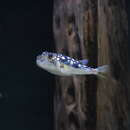Comprehensive Description
(
Inglês
)
fornecido por Smithsonian Contributions to Zoology
Amblyrhynchotes honckenii (Bloch)
A 1α completely covers A 2α posterodorsolaterally. The ventral bundle of A 1β is well developed, and reaches as far as the rear of the orbit posteriorly. The separation of the two bundles of A 2α is more distinct, and A 2β is not as well developed. The anterolateral bundle of the dilatator operculi inserts on the anterodorsal face of the opercle and subopercle.
The pharyngoclavicularis externus consists of two parts, the anterior inserting on basibranchial 3 (where it is partly confluent with the pharyngoclavicularis internus), the posterior part inserting on the anteroventral face of ceratobranchial 5. The obliquus posterior is well developed, and distinct from the sphincter oesophagi. The inclinator analis to the first ray now inserts on the cartilagenous distal pterygiophore and not on the base of the first ray. The infracarinalis medius is somewhat distinct. It attaches anteriorly to the posteroventral tip of the cleithrum, and becomes continuous with the longitudinal cutaneous in the midregion. It separates from the cutaneous again posteriorly to attach to the first anal pterygiophore. The hypochordal longitudinalis inserts on rays D 2–4, while the transversus caudalis inserts on rays V 2–3.
Colomesus psittacus (Bloch and Schneider)
A 1α and A 1β are as for A. honckenii. A 2α, which is not particularly well separated into two heads, has a high dorsal origin from the ventral surface of the lateral process of the hyomandibular, and has increased in bulk. A 2β has expanded across what was the dilatator fossa, and extends its origin posterodorsally onto the sphenotic, the posterior tip of the frontal, the supraoccipital, epiotic, and pterotic. The dilatator operculi is well developed, and inserts on the anterodorsal face of the subopercle, posterodorsal interopercle, and the opercle. Origin has greatly expanded to include the dorsal faces of the prefrontal, frontal, supraoccipital, epiotic, and pterotic. The anterior fibers cover the posterodorsomedial fibers of A 2β. The hyomandibular is not included in the sites of origin. The levator arcus palatini is very small.
There is no section of the hyohyoidei abductores to the fourth ray. The posteroventral bundle of the semicircular portion of the hyohyoidei adductores attaches to the ventrolateral face of the fourth radial. Two slips of fibers pass inward to the medial face of the posterodorsal bundle. One passes dorsomedially to attach to the posteromedial face of epibranchial 3, the other passes posteroventrally to fade out lateral to the pharyngoclavicularis internus. Both lie lateral to the posterior fibers of levator externus IV.
There are no fibers from levator externus I to epibranchial 2, and only a few from levator II to the fascia between epibranchials 2 and 3. No other fibers attach to epibranchial 3. Levator externus IV is well developed. No lateral bundle of transversus dorsalis II was found, but it may be represented by a dorsomedial bundle which passes out laterally to join the posterodorsal part of the hyohyoidei adductores.
The hypochordal longitudinalis inserts on rays D 2–4, while the transversus caudalis inserts on rays V 2–3. The flexor ventralis externus inserts on the bases of rays V 1–3, and its origin is expanded distally onto the haemal spines.
- citação bibliográfica
- Winterbottom, Richard. 1974. "The familial phylogeny of the Tetraodontiformes (Acanthopterygii: Pisces) as evidenced by their comparative myology." Smithsonian Contributions to Zoology. 1-201. https://doi.org/10.5479/si.00810282.155

